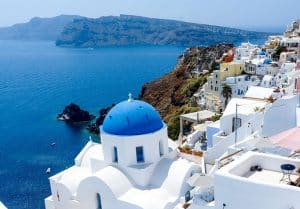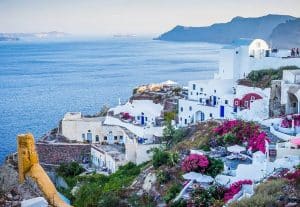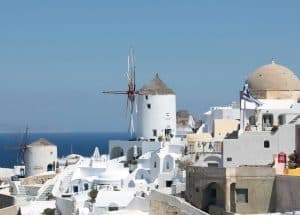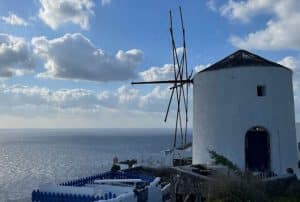Information about Oia village in Santorini

Oia is considered one of the most picturesque parts of Greece and one of the most famous destinations around the world for its sunset, with a strong traditional character. In 1993,Oia was designated a traditional settlement by presidential decree and the whole of Santorini as an area of “outstanding natural beauty”.
The current name is due to the Venetians, while in the past the name of the settlement was Pano Meria or Castle of Agios Nikolaos. Its traditional settlement is the first preserved in Greece and the old capital of Santorini, also called Apano Meria or Anomeria and the inhabitants Apanomerites.
A characteristic of the uniqueness of Oia is the fact that visitors to the village, from whichever direction they turn their gaze to the sky or to the sea, will not see overhead cables anywhere. The settlement is standard and all networks are underground! Oia was one of the five castles of Santorini, it was built in 1450 during the Venetian rule, on the edge of the caldera and was called the castle of Agios Nikolaos Apanomeria.
Residential expansion of Oia
Over time, the residential area expanded westward above Amoudi and included the mills, which belonged to the feudal lords, for their protection. Barley and beans were milled here and the complexes also had ovens. In 1890 Oia had a small shipyard and 130 ships belonging to its inhabitants, whose main occupation was the transit trade of the Eastern Mediterranean, especially between Russia and Alexandria. This is how the Theraic shipping flourished until the 20th century, when sailing ships gave way to steamships, a development that the village could not follow. .
Earthquake of 1956
The earthquake of 1956 caused great damage to the village, after parts of the ground collapsed into the sea. Oia was deserted and the inhabitants moved to Piraeus, but they returned in the 1980s and gradually the village revived. The contribution of the National Tourism Organization (NTO) was quite significant. In the years 1976-1991, 60 traditional buildings were restored in the center of Oia, as well as in Perivolas and Ammoudi, to be used as guesthouses.
Neighborhoods of Oia

The new neighborhood is the neighborhood that was built after the 1956 earthquake and where most of the locals live today. Sights in Oia are the Castle of Agios Nikolaos, today a part of the Goula (tower) is preserved, but it is considered the most sought-after spot to admire the sunset. It got its name from the cave church dedicated to Agios Nikolaos that was built around 1450.
Oia architecture

Old churches with blue domes, complete the romantic scene in Oia. The Maritime Museum is housed in an old captain’s house and houses an impressive collection of nautical finds that belonged to Santorini’s ship owners.
The farmers’ neighborhood of Perivolas, which is located in the eastern quarter and is now connected to the rest of the village. Here were the farmhouses with the canavades (wineries) now most of them have been converted into hotels.
What to do and see

Oia has all the tourist infrastructure of a modern destination, a rich market with commercial shops, restaurants for coffee and food and accommodation with impressive views. The central marble street, parallel to the caldera, together with the alleys perpendicular to it constitutes the “heart” of Oia, leading to Goulas and Perivolas.
Nearby beaches are Amoudi, a small port just below the settlement, where in the past it was the loading port of the merchant ships of the village, which loaded wine and game land.
Armeni, a small port below the settlement of Oia, which was also used by the old merchants to load their ships. The beach of Katharos or Kantharos, Baxedes or Paradisos and Kolumpos.
How to get there
Oia is connected daily by several routes with municipal transport, especially in the summer months, with Fira, the capital of the island, which is about 11 kilometers away.
